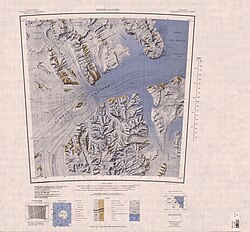Mount Lysaght
Exploration and name
Mount Markham was discovered by the British National Antarctic Expedition of 1901–1904). It is named for Sir Clements Markham, who, as President of the Royal Geographical Society, planned the expedition and chose Robert Falcon Scott as its leader.
Location

Mount Markham is in the northern part of the Queen Elizabeth Range. It is south of Mount Cara, east of the Frigate Range and the head of the Kent Glacier, and northeast of the Markham Plateau. Nearby features include Mount Lysaght to the north, Mount Katsufrakis to the south and Haven Hill, Mount Tedrow and Mount Predoehl to the east.
Nearby features
Markham Plateau
82°56′S 161°10′E / 82.933°S 161.167°E. A small, but prominent, high plateau which extends south from Mount Markham for about 10 nautical miles (19 km; 12 mi) and forms the divide between east and west-flowing glaciers in the north part of the Queen Elizabeth Range. Mapped by the United States Geological Survey (USGS) from tellurometer surveys and Navy air photos, 1960-62. Named by the United States Advisory Committee on Antarctic Names (US-ACAN) in association with Mount Markham.
Mount Lysaght
82°49′S 161°19′E / 82.817°S 161.317°E. A peak, 3,755 metres (12,320 ft) high, standing 1.5 nautical miles (2.8 km; 1.7 mi) north of Mount Markham. Discovered and named by the British Antarctic Expedition, 1907–09.
Mount Korsch
82°52′S 160°56′E / 82.867°S 160.933°E. A pyramidal peak, rising to about 4,000 metres (13,000 ft) high on the northwest margin of the Markham Plateau, 3 nautical miles (5.6 km; 3.5 mi) west of Mount Markham. Named by US-ACAN in 1988 after geologist Russell J. Korsch who, with E. Stump and D. Egerton, climbed and geologically mapped this peak on December 3, 1985, as a member of a USARP field party. Korsch was a member of United States Antarctic Research Program (USARP) field parties, 1968-69 and 1985-86; NZARP field parties, 1982-83 and 1984-85.
Mount Katsufrakis
82°58′S 161°38′E / 82.967°S 161.633°E. A projecting-type mountain on the east side of Markham Plateau. Mapped by the USGS from tellurometer surveys and Navy air photos, 1960-62. Named by the US-ACAN for John P. Katsufrakis, USARP radio scientist at McMurdo Station, 1963-64, and Byrd Station, 1964-65 and 1965-66.
Haven Hill
82°53′S 162°36′E / 82.883°S 162.600°E. A hill 2 nautical miles (3.7 km; 2.3 mi) west of Mount Tedrow, on the south side of Kent Glacier. Mapped by the USGS from tellurometer surveys and Navy air photos, 1960-62. Named by US-ACAN for Stoner B. Haven, USARP biologist at McMurdo Sound, 1960.
Mount Tedrow
82°53′S 163°00′E / 82.883°S 163.000°E. A mountain, 1,490 metres (4,890 ft) high, standing at the east side of the mouth of DeBreuck Glacier at its juncture with Kent Glacier. Mapped by the USGS from tellurometer surveys and Navy air photos, 1960-62. Named by the US-ACAN for Jack V. Tedrow, USARP glaciologist at McMurdo Station, 1959-60, 1960-61.
Mount Predoehl
82°56′S 163°11′E / 82.933°S 163.183°E. A partly snow-covered mountain, 1,710 metres (5,610 ft) high, just north of lower Pavlak Glacier. Mapped by the USGS from tellurometer surveys and Navy air photos, 1960-62. Named by the US-ACAN for Martin C. Predoehl, USARP meteorologist at McMurdo Station, 1961-62 and 1962-63.
References
- ^ Antarctica Ultra-Prominences.
- ^ "World Ribus – Transantarctic Mountains". World Ribus. Retrieved 2024-12-26.
- ^ Alberts 1995, p. 462.
- ^ Nimrod Glacier USGS.
- ^ Alberts 1995, p. 450.
- ^ Alberts 1995, p. 402.
- ^ Alberts 1995, p. 384.
- ^ Alberts 1995, p. 319.
- ^ Alberts 1995, p. 736.
- ^ Alberts 1995, p. 588.
Sources
- Alberts, Fred G., ed. (1995), Geographic Names of the Antarctic (PDF) (2 ed.), United States Board on Geographic Names, retrieved 2023-12-03
 This article incorporates public domain material from websites or documents of the United States Board on Geographic Names.
This article incorporates public domain material from websites or documents of the United States Board on Geographic Names. - "Antarctica Ultra-Prominences". peaklist.org. Retrieved 2011-12-24.
- Nimrod Glacier, USGS: United States Geological Survey, retrieved 2024-01-03
 This article incorporates public domain material from websites or documents of the United States Geological Survey.
This article incorporates public domain material from websites or documents of the United States Geological Survey.